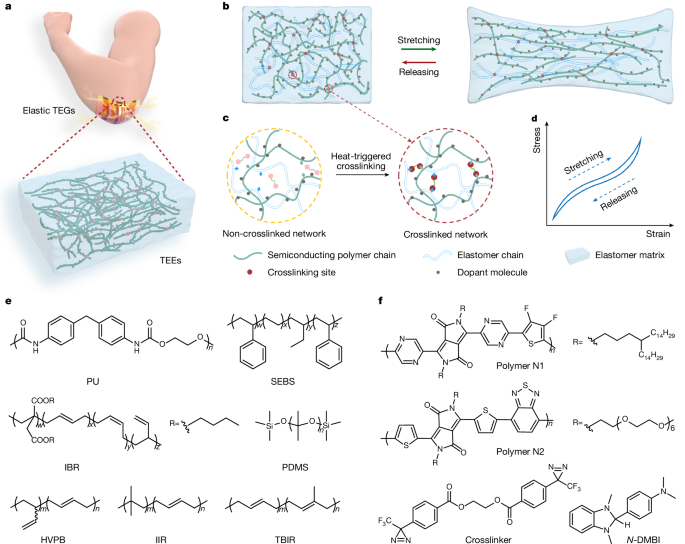Hou, C. & Zhu, M. Semiconductors flex thermoelectric power. Science 377, 815–816 (2022).
Hong, S. et al. Wearable thermoelectrics for personalized thermoregulation. Sci. Adv. 5, eaaw0536 (2019).
Yang, Q. et al. Flexible thermoelectrics based on ductile semiconductors. Science 377, 854–858 (2022).
Wei, T.-R. et al. Exceptional plasticity in the bulk single-crystalline van der Waals semiconductor InSe. Science 369, 542–545 (2020).
Bell, L. E. Cooling, heating, generating power, and recovering waste heat with thermoelectric systems. Science 321, 1457–1461 (2008).
Shi, X.-L., Zou, J. & Chen, Z. G. Advanced thermoelectric design: from materials and structures to devices. Chem. Rev. 120, 7399 (2020).
Shi, X. & He, J. Thermopower and harvesting heat. Science 371, 343–344 (2021).
Jia, Y. et al. Wearable thermoelectric materials and devices for self-powered electronic systems. Adv. Mater. 33, 2102990 (2021).
Bahk, J.-H., Fang, H., Yazawa, K. & Shakouri, A. Flexible thermoelectric materials and device optimization for wearable energy harvesting. J. Mater. Chem. C 3, 10362–10374 (2015).
Peng, J. et al. 3D extruded composite thermoelectric threads for flexible energy harvesting. Nat. Commun. 10, 5590 (2019).
Han, S. et al. Multiscale nanowire-microfluidic hybrid strain sensors with high sensitivity and stretchability. npj Flex. Electron. 2, 16 (2018).
Qin, B. et al. Moving fast makes for better cooling: optimizing carrier mobility with composition and processing is key for thermoelectric coolers. Science 378, 832–833 (2022).
Mallick, M. M. et al. High figure-of-merit telluride-based flexible thermoelectric films through interfacial modification via millisecond photonic-curing for fully printed thermoelectric generators. Adv. Sci. 9, 2202411 (2022).
Tian, Y. et al. Facile fabrication of flexible and high-performing thermoelectrics by direct laser printing on plastic foil. Adv. Mater. 36, 2307945 (2024).
Gao, H. et al. Transition metal-catalysed molecular n-doping of organic semiconductors. Nature 599, 67–73 (2021).
Feng, K., Guo, H., Sun, H. & Guo, X. N-type organic and polymeric semiconductors based on bithiophene imide derivatives. Acc. Chem. Res. 54, 3804–3817 (2021).
Zheng, Y.-Q. et al. Monolithic optical microlithography of high-density elastic circuits. Science 373, 88–94 (2021).
Jiang, Y. et al. A universal interface for plug-and-play assembly of stretchable devices. Nature 614, 456–462 (2023).
Zhang, Z. et al. High-brightness all-polymer stretchable LED with charge-trapping dilution. Nature 603, 624–630 (2022).
Zhong, D. et al. High-speed and large-scale intrinsically stretchable integrated circuits. Nature 627, 313–320 (2024).
Kim, N. et al. Elastic conducting polymer composites in thermoelectric modules. Nat. Commun. 11, 1424 (2020).
Tseng, C.-C. et al. Intrinsically stretchable organic thermoelectric polymers enabled by incorporating fused-ring conjugated breakers. Small 20, 2401966 (2024).
Wang, S., Zuo, G., Kim, J. & Sirringhaus, H. Progress of conjugated polymers as emerging thermoelectric materials. Prog. Polym. Sci. 129, 101548 (2022).
Yan, X. et al. Approaching disorder-tolerant semiconducting polymers. Nat. Commun. 12, 5723 (2021).
Han, Y., Tetik, H. & Malakooti, M. H. 3D soft architectures for stretchable thermoelectric wearables with electrical self-healing and damage tolerance. Adv. Mater. 36, 2407073 (2024).
Han, Y., Simonsen, L.-E. & Malakooti, M. H. Printing liquid metal elastomer composites for high-performance stretchable thermoelectric generators. Adv. Energy Mater. 12, 2201413 (2022).
Xu, J. et al. Highly stretchable polymer semiconductor films through the nanoconfinement effect. Science 355, 59–64 (2017).
Anwar, O. et al. Hansen parameter evaluation for the characterization of titania photocatalysts using particle size distributions and combinatorics. Nanoscale 14, 13593–13607 (2022).
Fernández-Rico, C. et al. Elastic microphase separation produces robust bicontinuous materials. Nat. Mater. 23, 124–130 (2023).
Lepage, M. L. et al. A broadly applicable cross-linker for aliphatic polymers containing C-H bonds. Science 366, 875–878 (2019).
Wu, H.-C. et al. A rapid and facile soft contact lamination method: Evaluation of polymer semiconductors for stretchable transistors. Chem. Mater. 26, 4544–4551 (2014).
Yang, C.-Y. et al. A thermally activated and highly miscible dopant for n-type organic thermoelectrics. Nat. Commun. 11, 3292 (2020).
Wei, P., Oh, J. H., Dong, G. & Bao, Z. Use of a 1H-benzoimidazole derivative as an n-type dopant and to enable air-stable solution-processed n-channel organic thin-film transistors. J. Am. Chem. Soc. 132, 8852–8853 (2010).
Liu, J. et al. Thermal conductivity and elastic constants of PEDOT:PSS with high electrical conductivity. Macromolecules 48, 585–591 (2015).
Brunetti, I., Dash, A., Scheunemann, D. & Kemerink, M. Is the field of organic thermoelectrics stuck? J. Mater. Res. 39, 1197–1206 (2024).
Wang, D. et al. Multi-heterojunctioned plastics with high thermoelectric figure of merit. Nature 632, 528–535 (2024).
Qian, X., Zhou, J. & Chen, G. Phonon-engineered extreme thermal conductivity materials. Nat. Mater. 20, 1188–1202 (2021).
Fan, Z., Du, D., Guan, X. & Ouyang, J. Polymer films with ultrahigh thermoelectric properties arising from significant Seebeck coefficient enhancement by ion accumulation on surface. Nano Energy 51, 481–488 (2018).
Jiang, Y. et al. Topological supramolecular network enabled high-conductivity, stretchable organic bioelectronics. Science 375, 1411–1417 (2022).
Zhou, T. et al. 3D printable high-performance conducting polymer hydrogel for all-hydrogel bioelectronic interfaces. Nat. Mater. 22, 895–902 (2023).
He, H. et al. Salt-induced ductilization and strain-insensitive resistance of an intrinsically conducting polymer. Sci. Adv. 8, eabq8160 (2022).
Wei, H. et al. Orthogonal photochemistry-assisted printing of 3D tough and stretchable conductive hydrogels. Nat. Commun. 12, 2082 (2021).
Chen, X.-X. et al. High-mobility semiconducting polymers with different spin ground states. Nat. Commun. 13, 2258 (2022).
Nan, K. et al. Compliant and stretchable thermoelectric coils for energy harvesting in miniature flexible devices. Sci. Adv. 4, eaau5849 (2018).
Lv, H. et al. A flexible spring-shaped architecture with optimized thermal design for wearable thermoelectric energy harvesting. Nano Energy 88, 106260 (2021).
Tian, Y. & Molina-Lopez, F. Boosting the performance of printed thermoelectric materials by inducing morphological anisotropy. Nanoscale 13, 5202–5215 (2021).
Yu, Z.-D. et al. High n-type and p-type conductivities and power factors achieved in a single conjugated polymer. Sci. Adv. 9, eadf3495 (2023).
Lu, Y. et al. Rigid coplanar polymers for stable n-type polymer thermoelectrics. Angew. Chem. Int. Ed. 58, 11390–11394 (2019).
Liu, J. et al. N-type organic thermoelectrics: demonstration of ZT > 0.3. Nat. Commun. 11, 5694 (2020).


